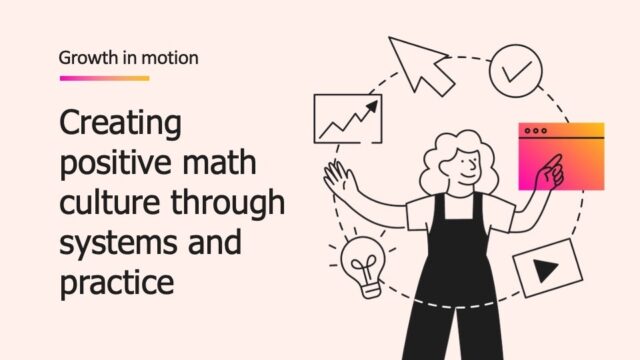
Many educators are familiar with the story of the young girl who came across a group of starfish washed up on a beach and drying out in the hot sun. The young girl began picking up the starfish one by one and gently tossed them back into the ocean. Observers nearby said it wouldn't be possible to save all the starfish since there were so many. The young person acknowledged the challenge and added that it would make a difference on an individual level.
It's a well-loved parable highlighting the importance of each student and the impact educators can have. Teachers are closest to the possibility of reaching each student in such an impactful way. However, district and school leaders must address the challenge at scale, ensuring interventions improve student outcomes across entire schools and districts. The urgency of improving student learning requires a strategic approach to designing systems that can sustain progress at scale.
Implementation at scale is only as effective as the systems in place for intervention assessment.
Design Thinking Innovation Manager, Innovate Carolina, University of North Carolina, Chapel Hill
Designing a scalable system for student success
With significant challenges ahead for teaching and learning, districts continue to work toward designing data-driven, scalable intervention systems that meet the needs of all students. While interventions will impact students individually, the larger system must be flexible, evidence-based, and robust to drive growth and progress at each stage of learning.
A comprehensive approach requires three key elements:
- A well-designed system grounded in clarity of purpose and goals, with high-quality, evidence-based materials and strategic actions.
- A professional learning framework that provides ongoing support and development for teachers and leaders.
- An accountability system to monitor implementation and impact effectively.
When these three elements are coordinated, and leaders share a deep understanding of purpose and goals, scaling student outcomes becomes possible.
Building system coherence to scale impact
Michael Fullan describes coherence as a "shared depth of understanding about what needs to be done and how to do it effectively across an entire system."* Leaders need to establish a clearly defined starting point to build that shared understanding.
Using a framework for system coherence brings all stakeholders together, ensuring that all voices are heard and all student needs are included. This requires district and school leaders to evaluate how their practices for using data, resources, and professional learning are designed to improve student outcomes. The process includes honest conversations, perspective sharing, gathering information, and thoughtful collaboration to ensure an inclusive, system-wide approach.
At the core of this work is data-driven decision-making—using reliable and valid data to build an understanding of student needs and then identifying the resources and strategies necessary to create an intervention system that works at scale.
Building capacity through data-driven professional learning
As leaders collaborate with stakeholders to implement interventions, professional learning is a critical component in driving successful student outcomes. To scale impact, teachers need a deep understanding of instructional resources, intervention strategies, and continuous professional growth opportunities.
Jeana Aycock, Director of Assessment and Intervention in Columbia Co., Georgia, shares that in her district, a key to building teacher capacity is providing monthly, data-driven training that gives teachers strategies based on student progress. This helps educators move beyond simple implementation and focus on impactful interventions.
Most schools have teachers with diverse levels of experience—from new educators to seasoned professionals. Leaders can leverage this diversity by designing personalized professional learning experiences that mirror the differentiated instruction planned for students.
Accountability: Monitoring implementation and impact
District and school leaders know that monitoring implementation and student progress is essential for success. Scaling interventions requires accountability at every level to ensure consistency and effectiveness.
Leaders have access to multiple types of data indicators that reflect engagement, resource usage, and instructional effectiveness. This helps them ensure that interventions are not only being used but also driving meaningful student progress.
Stefanie LaPolla, Supervisor of Multi-Tiered System of Supports (MTSS) in Loudoun County Public Schools, emphasizes the role of data-driven decision-making in scaling interventions. She notes that "data is used to help drive the best instructional fit for students and helps to personalize their experience, creating a learning pathway that is intentional and consistently monitored to promote student success."
By embedding data analysis and instructional alignment into intervention strategies, districts can scale successful practices across classrooms and schools.
A district-wide approach to scaling success
Elease McDonald, M.Ed., Curriculum Specialist for Secondary English Language Arts in Okaloosa Co., Florida, describes her district’s transformative approach to scaling intervention success. By integrating system coherence, professional learning, and accountability, her team identified an evidence-based instructional resource that provided structure, consistency, and measurable progress data.
Through intentional planning and implementation, she empowered teachers to build collective efficacy and strengthened the system’s ability to achieve significant student growth.
Driving student outcomes at scale
Improving student outcomes is a top priority for districts and schools nationwide. With committed educators and data-driven leadership, scaling successful interventions is possible. By focusing on coherent systems, professional learning, and accountability measures, districts can expand effective practices and drive sustainable student success.
***
For more on data-driven assessments and instruction, explore HMH assessments that help educators gain a complete picture of student achievement.
* Fullan, M., & Quinn, J. (2015). Coherence: The right drivers in action for schools, districts, and systems. Corwin Press.
Be the first to read the latest from Shaped.













